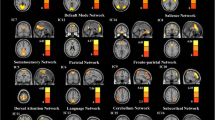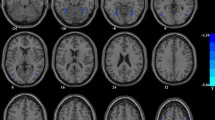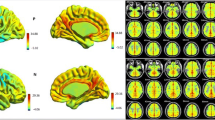Abstract
Decreased homotopic connectivity has been implicated in the neurophysiology of major depressive disorder (MDD) with inconsistent findings. A combination of clinical and methodological variabilities may account for the inconsistency, and thus limiting the reproducibility of the findings. The present study aims to examine voxel-mirrored homotopic connectivity (VMHC) alterations in two independent samples of patients with first-episode, drug-naive MDD. The samples included 59 patients and 31 controls from Sample 1 and 29 patients and 24 controls from Sample 2. VMHC was evaluated in both samples with an overlapping technique, which was used to define regions of abnormality common to both samples. Moreover, receiver operating characteristic curve and support vector machine were employed to differentiate the patients from the controls in both samples. Compared with the controls, the patients in both samples exhibited decreased VMHC in overlapped brain clusters, including the posterior cingulate cortex (PCC) and cuneus. Moreover, the VMHC values in the PCC and cuneus and a combination of the VMHC values in these two clusters could robustly discriminate between patients and controls with good sensitivities and specificities in both samples. This study is the first to examine VMHC abnormalities in first-episode, drug-naive patients with MDD in two independent samples by using an overlapped technique. The patients exhibit decreased VMHC in overlapping clusters in the posterior default-mode network and visual regions, which may be trait alterations for MDD. The present study provides a new perspective for understanding the neurophysiologic abnormalities of VMHC in MDD.




Similar content being viewed by others
References
Anderson, J. S., Druzgal, T. J., Froehlich, A., DuBray, M. B., Lange, N., Alexander, A. L., Abildskov, T., Nielsen, J. A., Cariello, A. N., Cooperrider, J. R., Bigler, E. D., & Lainhart, J. E. (2011). Decreased interhemispheric functional connectivity in autism. Cerebral Cortex (New York, N. Y.: 1991), 21, 1134–1146.
Belger, A., & Banich, M. T. (1992). Interhemispheric interaction affected by computational complexity. Neuropsychologia, 30, 923–929.
Chang, C. C., Hsu, C. W., & Lin, C. J. (2000). The analysis of decomposition methods for support vector machines. IEEE Transactions on Neural Networks/a Publication of the IEEE Neural Networks Council, 11, 1003–1008.
Fales, C. L., Barch, D. M., Rundle, M. M., Mintun, M. A., Mathews, J., Snyder, A. Z., & Sheline, Y. I. (2009) Antidepressant treatment normalizes hypoactivity in dorsolateral prefrontal cortex during emotional interference processing in major depression. Journal of Affective Disorders, 112, 206–211.
First, M. B., Spitzer, R. L., Gibbon, M., & Williams, J. B. W. (1997). Structured Clinical Interview for DSM-IV Axis I Disorders (SCID). Washington, DC: American Psychiatric Press.
Fusar-Poli, P., Placentino, A., Carletti, F., Landi, P., Allen, P., Surguladze, S., Benedetti, F., Abbamonte, M., Gasparotti, R., Barale, F., Perez, J., McGuire, P., & Politi, P. (2009) Functional atlas of emotional faces processing: a voxel-based meta-analysis of 105 functional magnetic resonance imaging studies. Journal of Psychiatry & Neuroscience, 34, 418–432.
Guo, W., Liu, F., Dai, Y., Jiang, M., Zhang, J., Yu, L., Long, L., Chen, H., Gao, Q., & Xiao, C. (2013a). Decreased interhemispheric resting-state functional connectivity in first-episode, drug-naive major depressive disorder. Progress in Neuropsychopharmacology and Biological Psychiatry, 41, 24–29.
Guo, W., Liu, F., Xue, Z., Gao, K., Liu, Z., Xiao, C., Chen, H., & Zhao, J. (2013b). Decreased interhemispheric coordination in treatment-resistant depression: a resting-state FMRI study. PLoS One, 8, e71368.
Guo, W., Jiang, J., Xiao, C., Zhang, Z., Zhang, J., Yu, L., Liu, J., & Liu, G. (2014a). Decreased resting-state interhemispheric functional connectivity in unaffected siblings of schizophrenia patients. Schizophrenia Research, 152, 170–175.
Guo, W., Xiao, C., Liu, G., Wooderson, S. C., Zhang, Z., Zhang, J., Yu, L., & Liu, J. (2014b). Decreased resting-state interhemispheric coordination in first-episode, drug-naive paranoid schizophrenia. Progress in Neuro-psychopharmacology & Biological Psychiatry, 48, 14–19.
Guo, W., Liu, F., Chen, J., Wu, R., Li, L., Zhang, Z., Chen, H., & Zhao, J. (2017a) Treatment effects of olanzapine on homotopic connectivity in drug-free schizophrenia at rest. World Journal of Biological Psychiatry, 1–9. https://doi.org/10.1080/15622975.2017.1346280.
Guo, W., Liu, F., Chen, J., Wu, R., Li, L., Zhang, Z., & Zhao, J. (2017b). Family-based case-control study of homotopic connectivity in first-episode, drug-naive schizophrenia at rest. Scientific Reports, 7. https://doi.org/10.1038/srep43312.
Guo, W., Cui, X., Liu, F., Chen, J., Xie, G., Wu, R., Zhang, Z., Chen, H., & Zhao, J. (2018). Increased anterior default-mode network homogeneity in first-episode, drug-naive major depressive disorder: A replication study. Journal of Affective Disorders, 225, 767–772.
Hahamy, A., Calhoun, V., Pearlson, G., Harel, M., Stern, N., Attar, F., Malach, R., & Salomon, R. (2014). Save the global: global signal connectivity as a tool for studying clinical populations with functional magnetic resonance imaging. Brain Connect, 4, 395–403.
Hoptman, M. J., & Davidson, R. J. (1994). How and why do the two cerebral hemispheres interact? Psychological Bulletin, 116, 195–219.
Hoptman, M. J., Zuo, X. N., D’Angelo, D., Mauro, C. J., Butler, P. D., Milham, M. P., & Javitt, D. C. (2012). Decreased interhemispheric coordination in schizophrenia: a resting state fMRI study. Schizophrenia Research, 141, 1–7.
Li, H. J., Xu, Y., Zhang, K. R., Hoptman, M. J., & Zuo, X. N. (2015) Homotopic connectivity in drug-naive, first-episode, early-onset schizophrenia. Journal of Child Psychology and Psychiatry, and Allied Disciplines, 56, 432–443.
Liu, F., Guo, W., Yu, D., Gao, Q., Gao, K., Xue, Z., Du, H., Zhang, J., Tan, C., Liu, Z., Zhao, J., & Chen, H. (2012). Classification of different therapeutic responses of major depressive disorder with multivariate pattern analysis method based on structural MR scans. PLoS One, 7, e40968.
Liu, F., Guo, W., Fouche, J. P., Wang, Y., Wang, W., Ding, J., Zeng, L., Qiu, C., Gong, Q., Zhang, W., & Chen, H. (2015) Multivariate classification of social anxiety disorder using whole brain functional connectivity. Brain Structure & Function, 220, 101–115.
Maddock, R. J. (1999). The retrosplenial cortex and emotion: new insights from functional neuroimaging of the human brain. Trends in Neurosciences, 22, 310–316.
Power, J. D., Barnes, K. A., Snyder, A. Z., Schlaggar, B. L., & Petersen, S. E. (2012). Spurious but systematic correlations in functional connectivity MRI networks arise from subject motion. NeuroImage, 59, 2142–2154.
Rosenblau, G., Sterzer, P., Stoy, M., Park, S., Friedel, E., Heinz, A., Pilhatsch, M., Bauer, M., & Strohle, A. (2012). Functional neuroanatomy of emotion processing in major depressive disorder is altered after successful antidepressant therapy. Journal of Psychopharmacology (Oxford, England), 26, 1424–1433.
Song, X. W., Dong, Z. Y., Long, X. Y., Li, S. F., Zuo, X. N., Zhu, C. Z., He, Y., Yan, C. G., & Zang, Y. F. (2011). REST: a toolkit for resting-state functional magnetic resonance imaging data processing. PLoS One, 6, e25031.
Su, Q., Yao, D., Jiang, M., Liu, F., Long, L., Dai, Y., Yu, M., Zhang, Z., Zhang, J., Liu, J., Xiao, C., Zhao, J., & Guo, W. (2016). Decreased interhemispheric functional connectivity in insula and angular gyrus/supramarginal gyrus: Significant findings in first-episode, drug-naive somatization disorder. Psychiatry Research, 248, 48–54.
Tang, Y., Wang, L., Cao, F., & Tan, L. (2012). Identify schizophrenia using resting-state functional connectivity: an exploratory research and analysis. Biomedical Engineering Online, 11, 50.
Wang, L., Li, K., Zhang, Q. E., Zeng, Y. W., Jin, Z., Dai, W. J., Su, Y. A., Wang, G., Tan, Y. L., Yu, X., & Si, T. M. (2013a). Interhemispheric functional connectivity and its relationships with clinical characteristics in major depressive disorder: a resting state FMRI study. PLoS One, 8, e60191.
Wang, X., Jiao, Y., Tang, T., Wang, H., & Lu, Z. (2013b). Altered regional homogeneity patterns in adults with attention-deficit hyperactivity disorder. European Journal of Radiology, 82, 1552–1557.
Yan, C. G., Wang, X. D., Zuo, X. N., & Zang, Y. F. (2016) DPABI: Data Processing & Analysis for (Resting-State) Brain Imaging. Neuroinformatics, 14, 339–351.
Zuo, X. N., Kelly, C., Di Martino, A., Mennes, M., Margulies, D. S., Bangaru, S., Grzadzinski, R., Evans, A. C., Zang, Y. F., Castellanos, F. X., & Milham, M. P. (2010). Growing together and growing apart: regional and sex differences in the lifespan developmental trajectories of functional homotopy. The Journal of Neuroscience: the Official Journal of the Society for Neuroscience, 30, 15034–15043.
Funding
This study was supported by grants from the National Key National Key R&D Program of China (2016YFC1307100 and 2016YFC1306900) and the National Natural Science Foundation of China (Grant Nos. 81571310, 81630033, 81771447, and 81471363).
Author information
Authors and Affiliations
Corresponding authors
Ethics declarations
Conflict of interest
Author Guo W declares that he has no conflict of interest. Author Cui X declares that she has no conflict of interest. Author Liu F declares that he has no conflict of interest. Author Chen J declares that he has no conflict of interest. Author Xie G declares that he has no conflict of interest. Author Wu R declares that she has no conflict of interest. Author Zhang Z declares that she has no conflict of interest. Author Chen H declares that he has no conflict of interest. Author Zhang X declares that he has no conflict of interest. Author Zhao J declares that he has no conflict of interest.
Ethical approval
All procedures performed in studies involving human participants were in accordance with the ethical standards of the institutional and/or national research committee and with the 1964 Helsinki declaration and its later amendments or comparable ethical standards.
Informed consent
Informed consent was obtained from all individual participants included in the study.
Rights and permissions
About this article
Cite this article
Guo, W., Cui, X., Liu, F. et al. Decreased interhemispheric coordination in the posterior default-mode network and visual regions as trait alterations in first-episode, drug-naive major depressive disorder. Brain Imaging and Behavior 12, 1251–1258 (2018). https://doi.org/10.1007/s11682-017-9794-8
Published:
Issue Date:
DOI: https://doi.org/10.1007/s11682-017-9794-8




